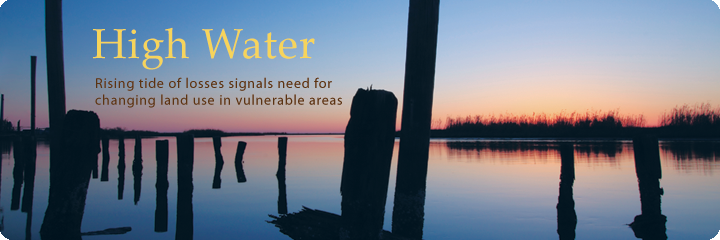
With meteorologists forecasting an extended, decade-long period of more and bigger tropical storms and hurricanes, a Binghamton researcher hopes to help coastal regions better withstand devastating winds and flooding by shaking up established thinking about building practices and land use.
Burrell Montz, professor of geography and environmental studies and graduate director of the Geography Department, focuses on the social, political and economic factors that shape land-use decisions, both before and after natural disasters. She concurs with Max Mayfield, director of the National Oceanic and Atmospheric Administration’s (NOAA’s) Tropical Prediction Center at the National Hurricane Center, who has said, “Preparedness remains essential. The most accurate forecasts are only beneficial when people react by taking the necessary steps to save their lives and property.“
From Montz’s perspective, life and property might be better protected if more thought was given to the steps taken in the weeks, months and years before a storm makes landfall in a region.
“The question,“ she said, “is who makes the decisions and who influences them? We want to keep people from making bad decisions because of a lack of information. We want them to go in with their eyes open.“
On average, a north Atlantic hurricane season produces 11 named storms, six of which would likely become hurricanes, two of them major. In 2005, the Atlantic hurricane season with a record 28 storms, including 15 hurricanes blew by those averages without a backward glance. Seven of that seasons hurricanes were considered major, and a record four, including Katrina, hit the United States. And we cannot forget those affected in previous years.
This was no fluke, according to the NOAA, which warns that more and stronger storms, along with greater chances of landfalls, are the hallmark of a naturally occurring cycle of increased hurricane activity that has been unfolding in the Atlantic since 1995. Caused by the interaction of atmospheric and oceanic conditions, including warm ocean waters, low wind shear and the pattern of easterly winds coming off the west coast of Africa, such cycles typically last 20 to 30 years or longer. At best, the current cycle is only about halfway through. In the face of unprecedented coastal population growth, this is a recipe for disaster, particularly with so little understanding of things such as what makes for a safe residence.
Conventional wisdom and even Florida building code, for instance holds that larger, more modern manufactured homes are safer than smaller, older ones. But Montz, who has studied flooding in and beyond the U.S. for nearly three decades, says recent research, based on computer mapping and statistical analysis of 500 manufactured homes in four Charlotte County, Fla., mobile-home parks, calls that assumption into question.
Manufactured homes are increasingly popular with snowbirds and retiring baby boomers throughout the South, and are particularly popular in Florida, where they represent about 12 percent of all homes. In the region where Katrina wreaked the most damage parts of Louisiana, Alabama, Mississippi and Texas between 6.9 and 15.8 percent of homes were manufactured homes, the Census Bureau reported.
Montz and one of her students, Matt Zayatz ’06, examined what happened to manufactured homes in Charlotte County when Hurricane Charley pummeled Florida in 2004. They found not only that the bigger, newer homes didn’t always fare better, but that even their orientation on lots whether they faced into, away from or in the direction of prevailing winds made no real difference.
Montz doesn’t expect people to simply stop living along the coast. After all, those areas are some of the most beautiful places in the country. But because her findings seem clear, she wants people who live in areas at risk for major wind damage or flooding to understand the dangers and have plans for evacuation and recovery; simply making homes bigger won’t necessarily make them less vulnerable.
Even in homes far from the coast, people are at risk if they live in hurricane alleys, Montz said. “Many hurricanes are more of a wind event,“ she said, “so storm surge isn’t what’s causing the damage.“ All of which points to a need for emergency managers, as well as homeowners, contractors and legislators who create building codes, to reconsider accepted approaches to risk management.
Montz’s work has important implications for U.S. taxpayers. Florida counties alone received about $3.3 billion in federal disaster aid during the 2004 hurricane season. In the wake of Hurricane Katrina in 2005, the Federal Emergency Management Agency distributed nearly $6 billion in aid to individuals and families affected by the storm’s fury.
If there is an upside to a major storm like Katrina, it is the attention it has brought to the issues of land use in disaster-prone areas, Montz said. She incorporated the storm and its aftermath into her classroom discussions. But she finds the politics surrounding recovery efforts in New Orleans distracting. Many Americans seem to believe that the racial and economic inequities Katrina revealed are unique to New Orleans, but that’s just not the case, she said.
A concern for lower-income, less-informed coastal residents drives her interest in the development of public policy that can better protect them and their homes. That may require adapting and revising building codes. But it might also involve such things as getting TV meteorologists to use more accessible or direct language to relay the threat as storms barrel toward the coast. It might also involve educating community leaders to value good sense over die-hard stoicism or ill-advised neighborhood loyalty.
page 1 | page 2